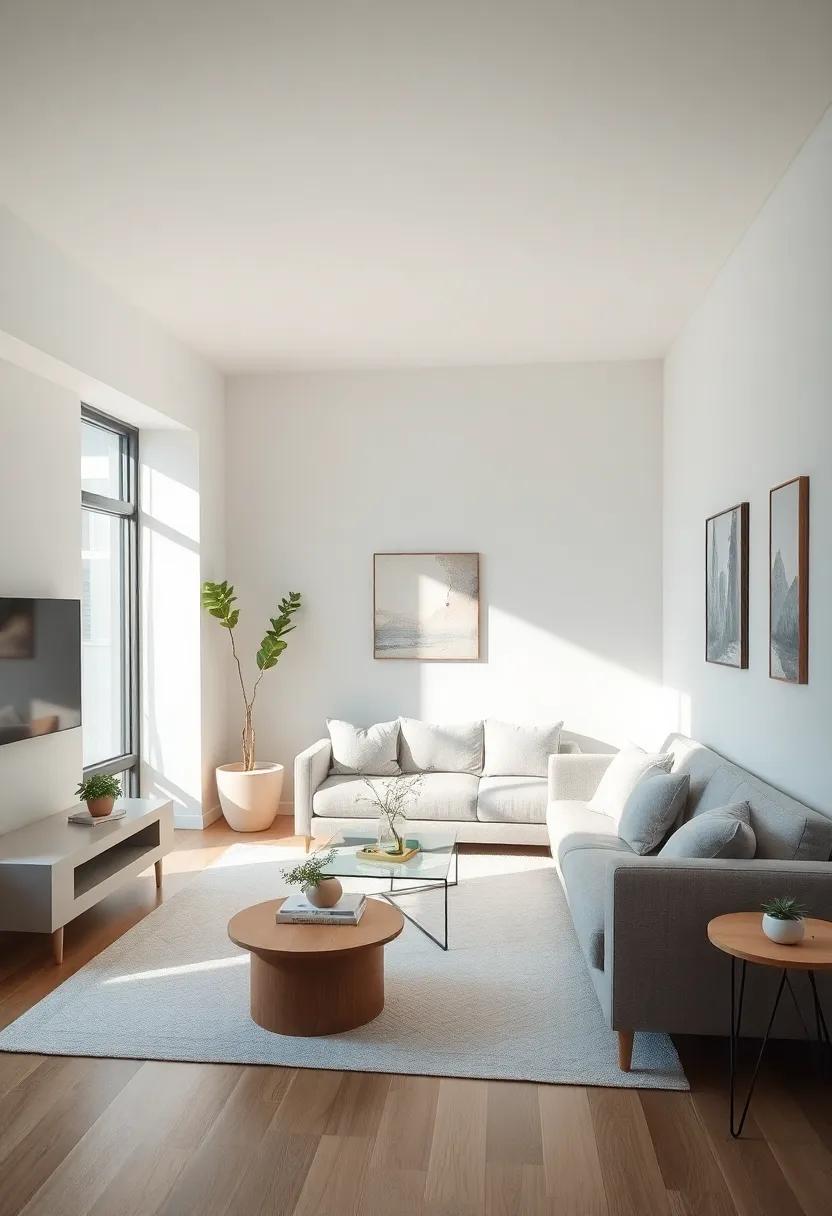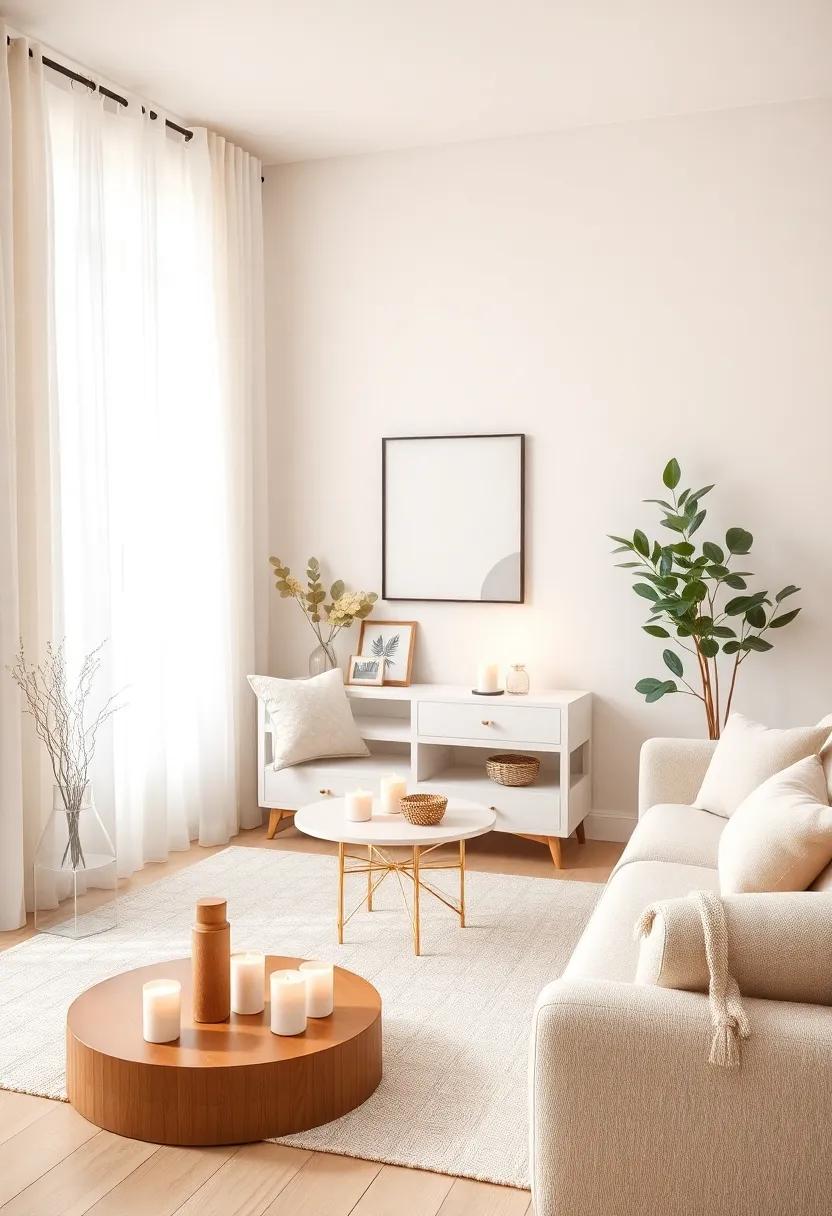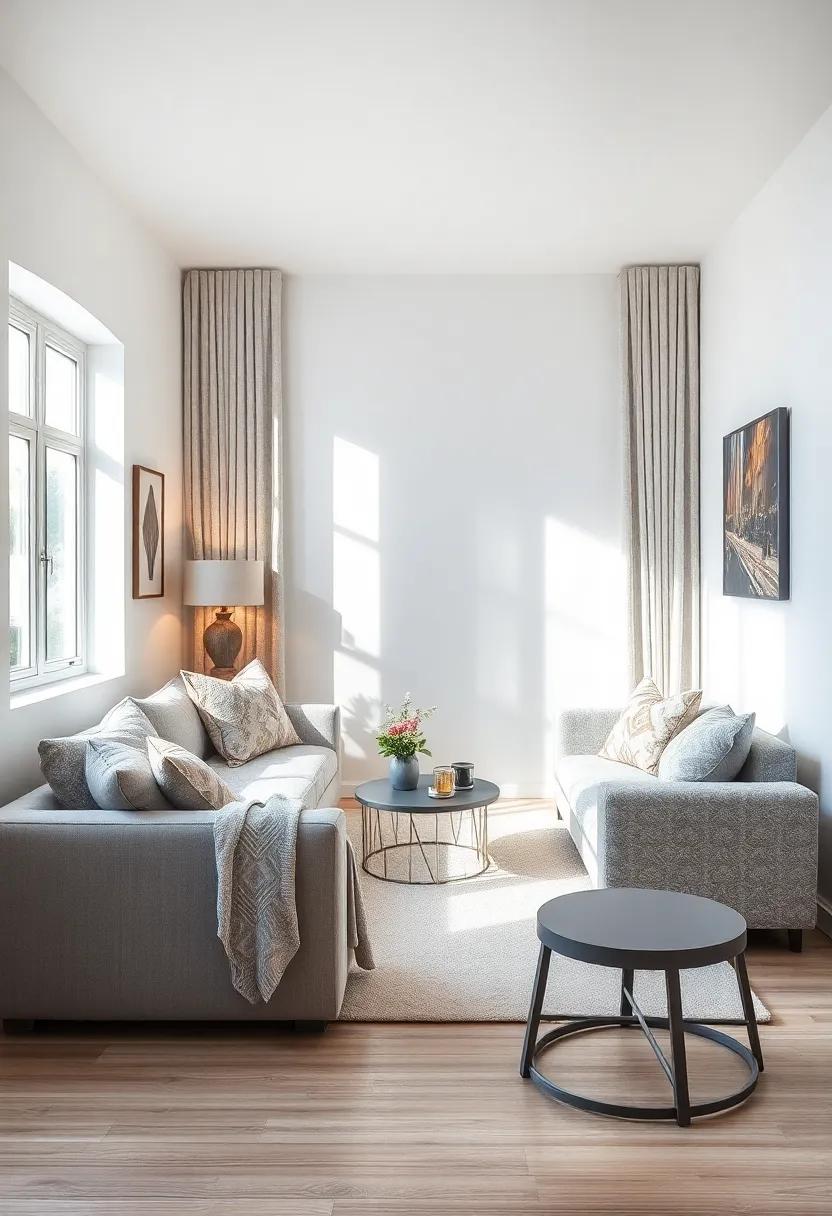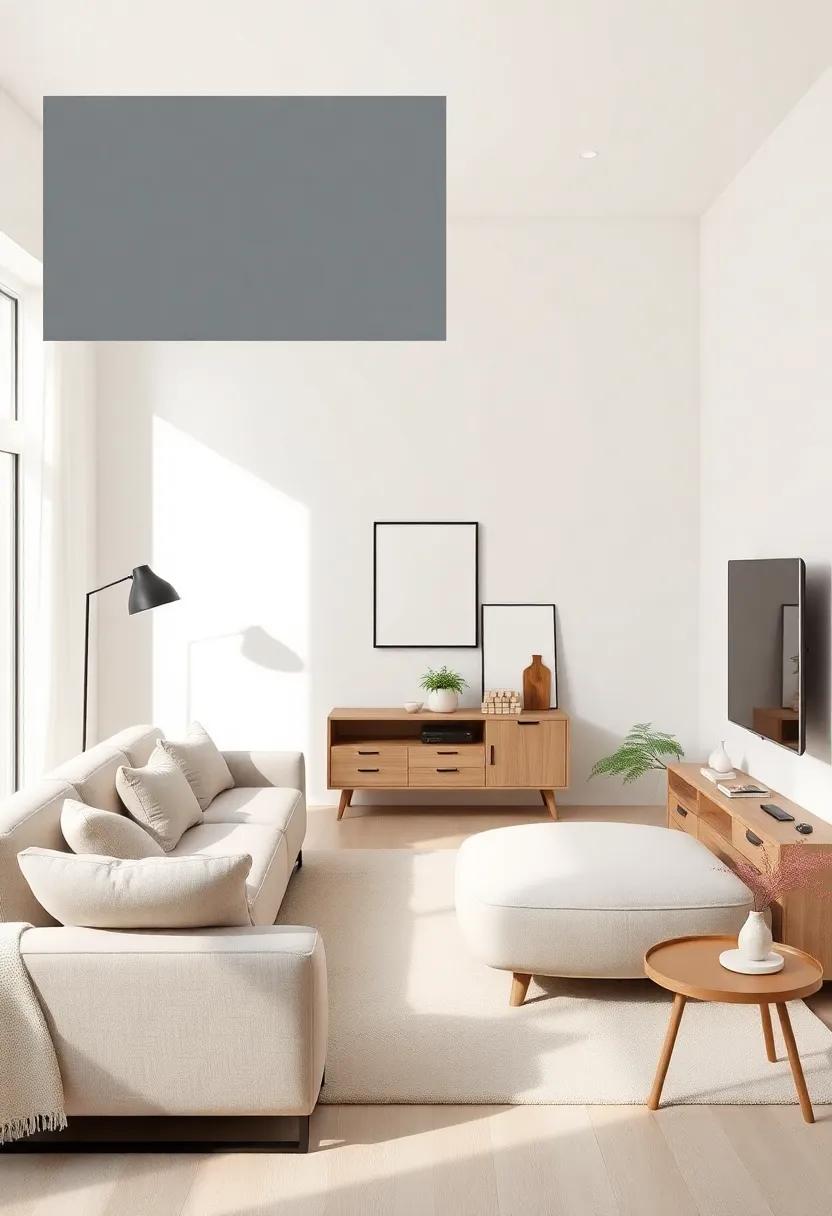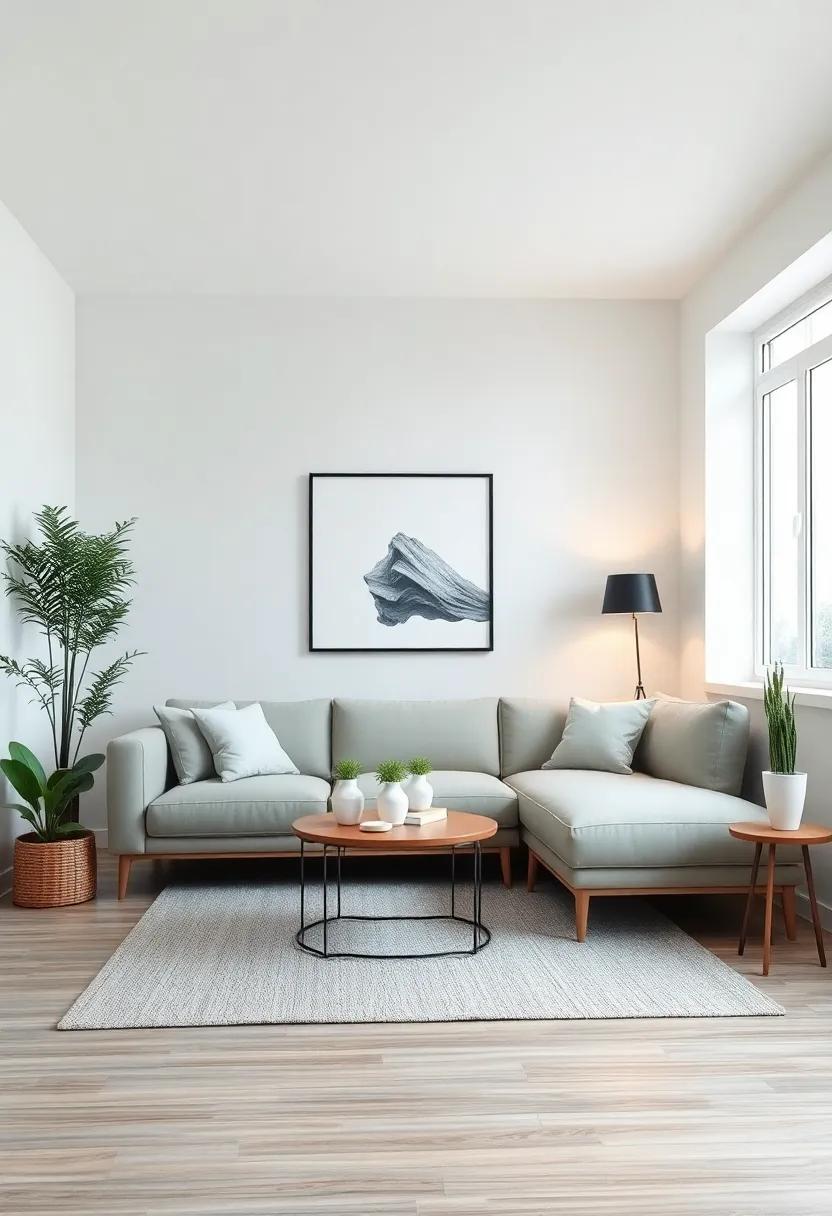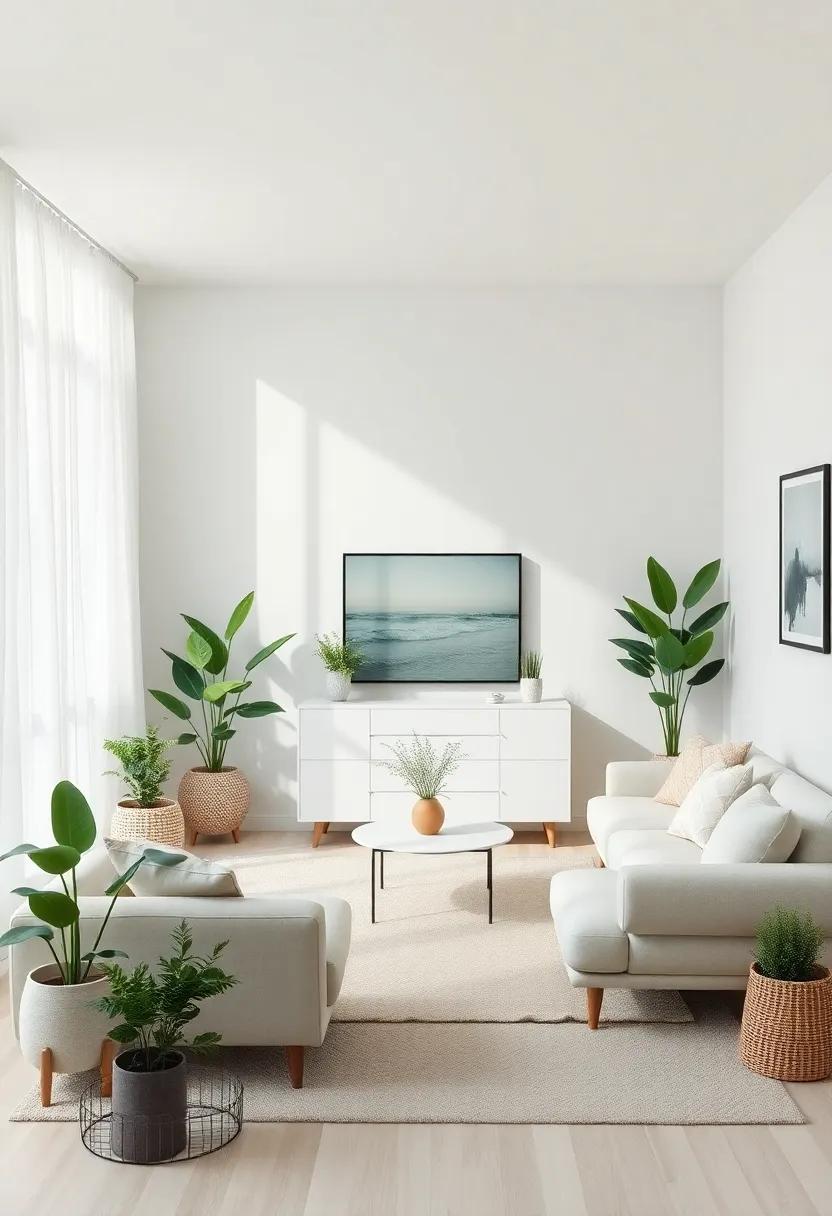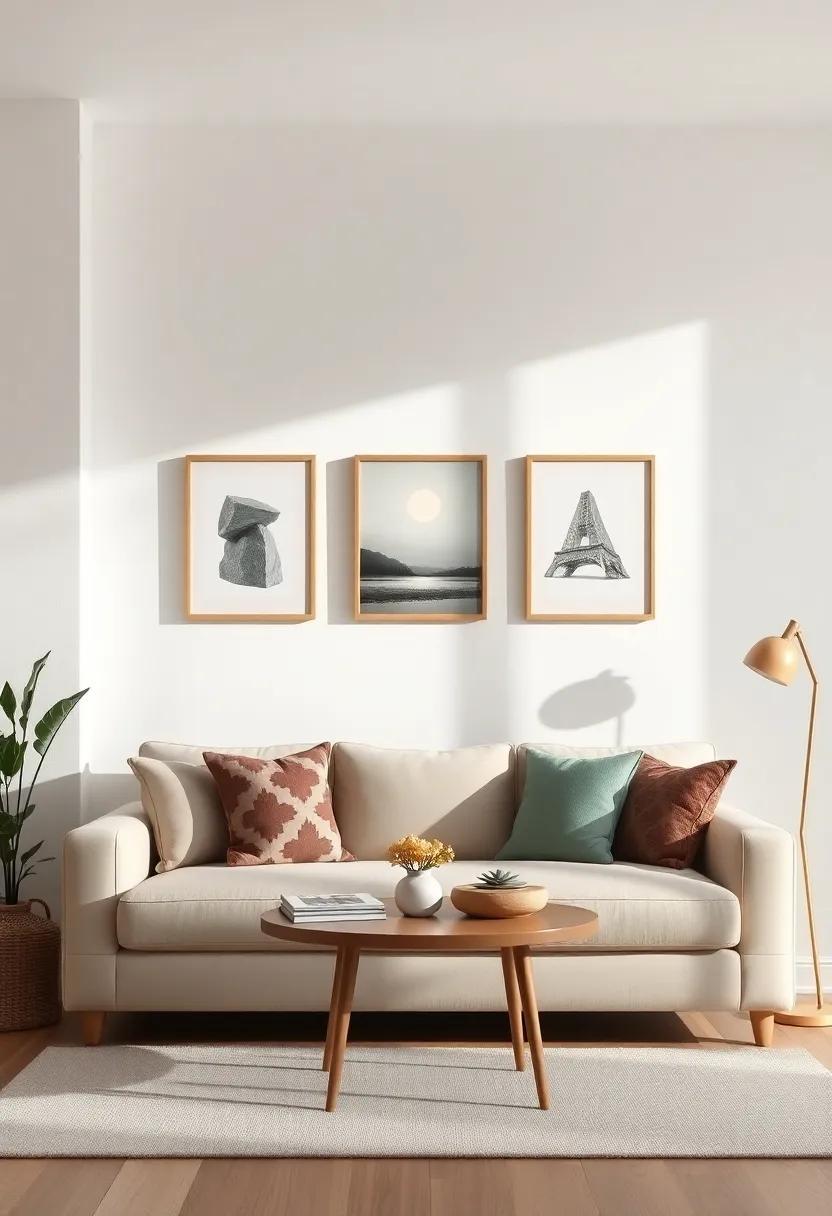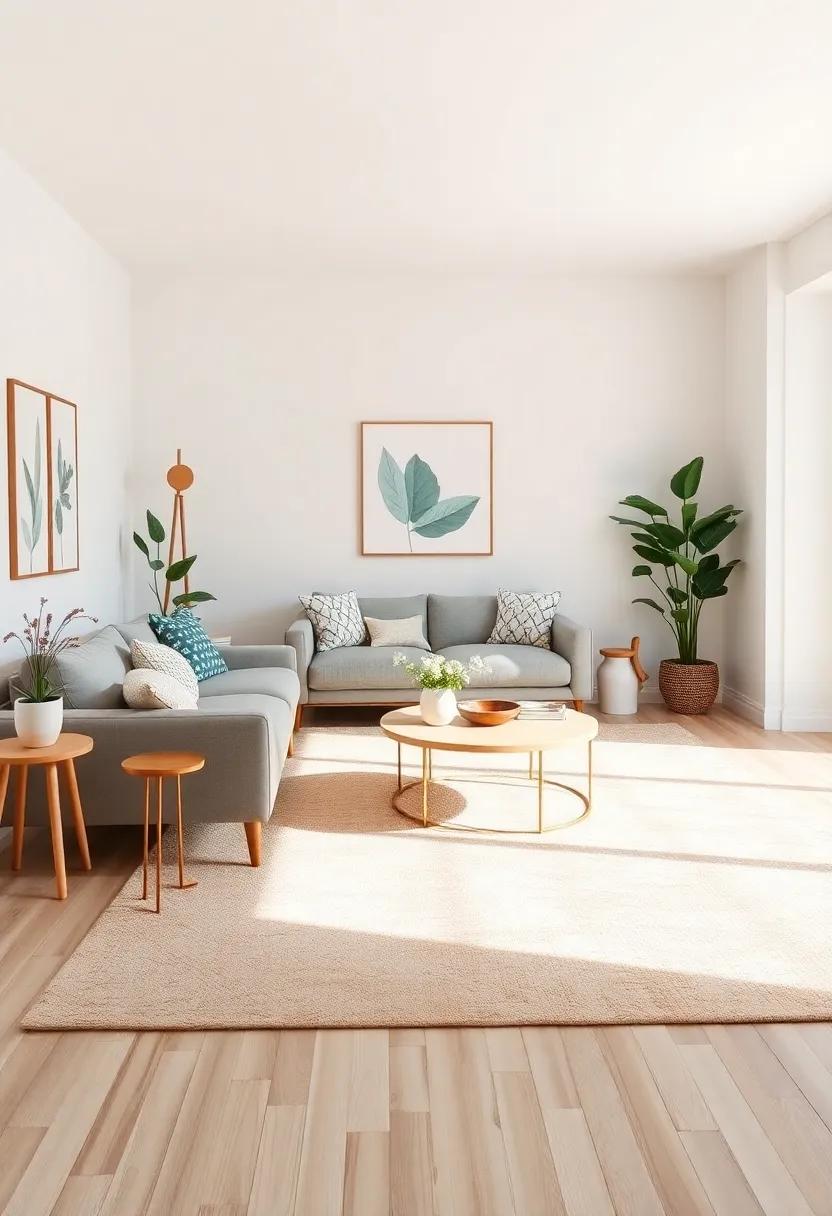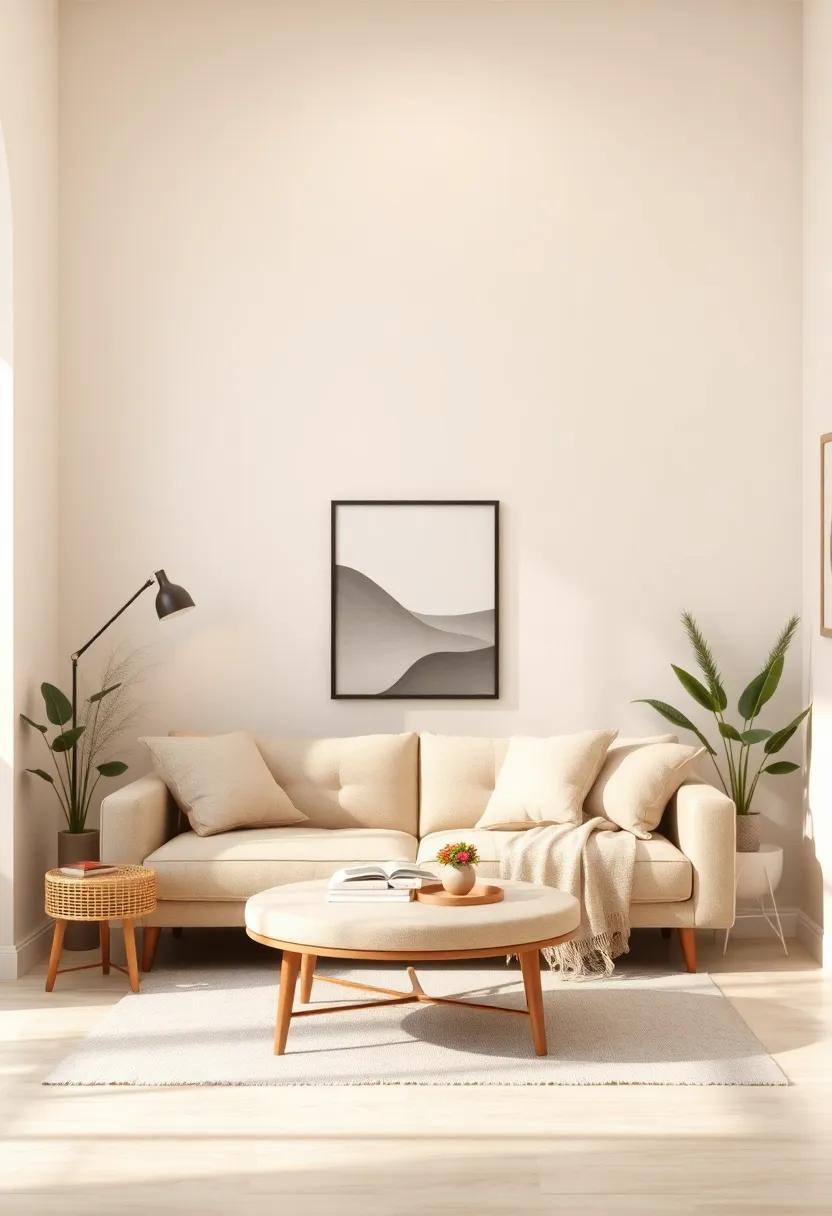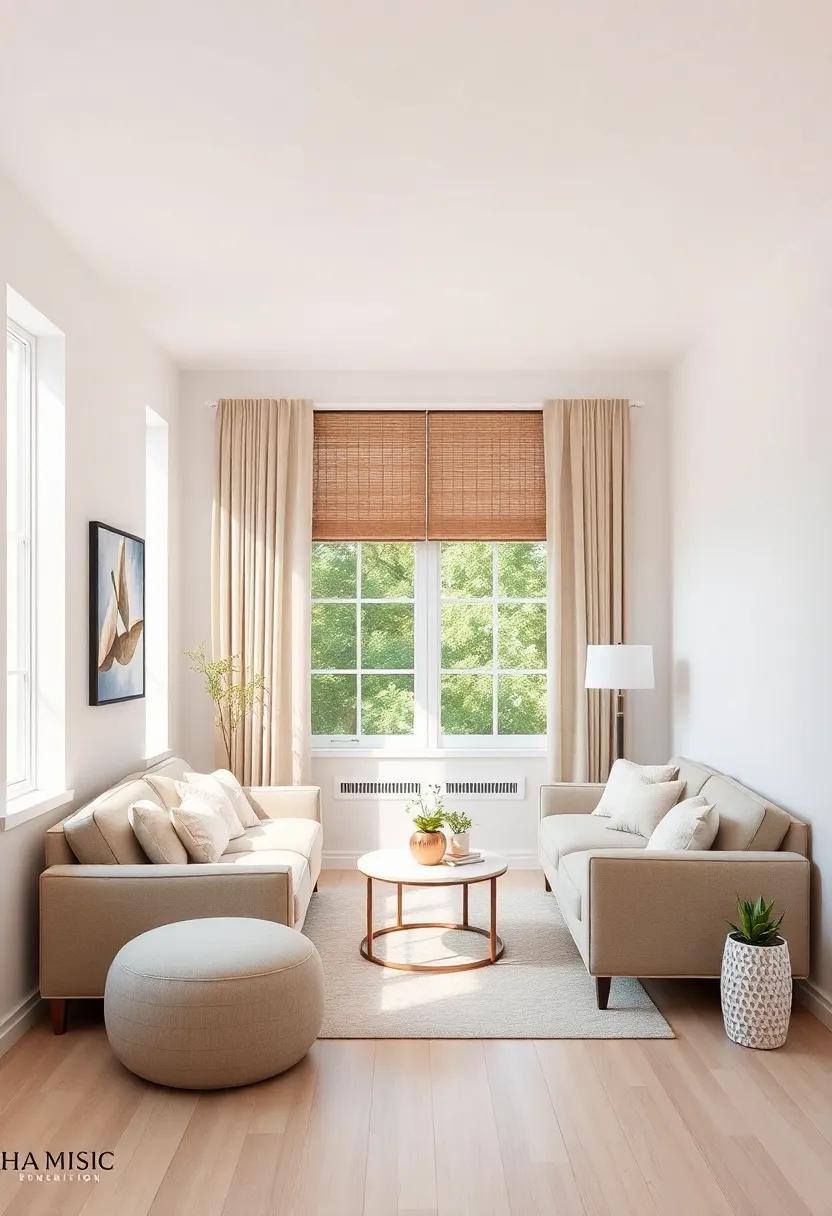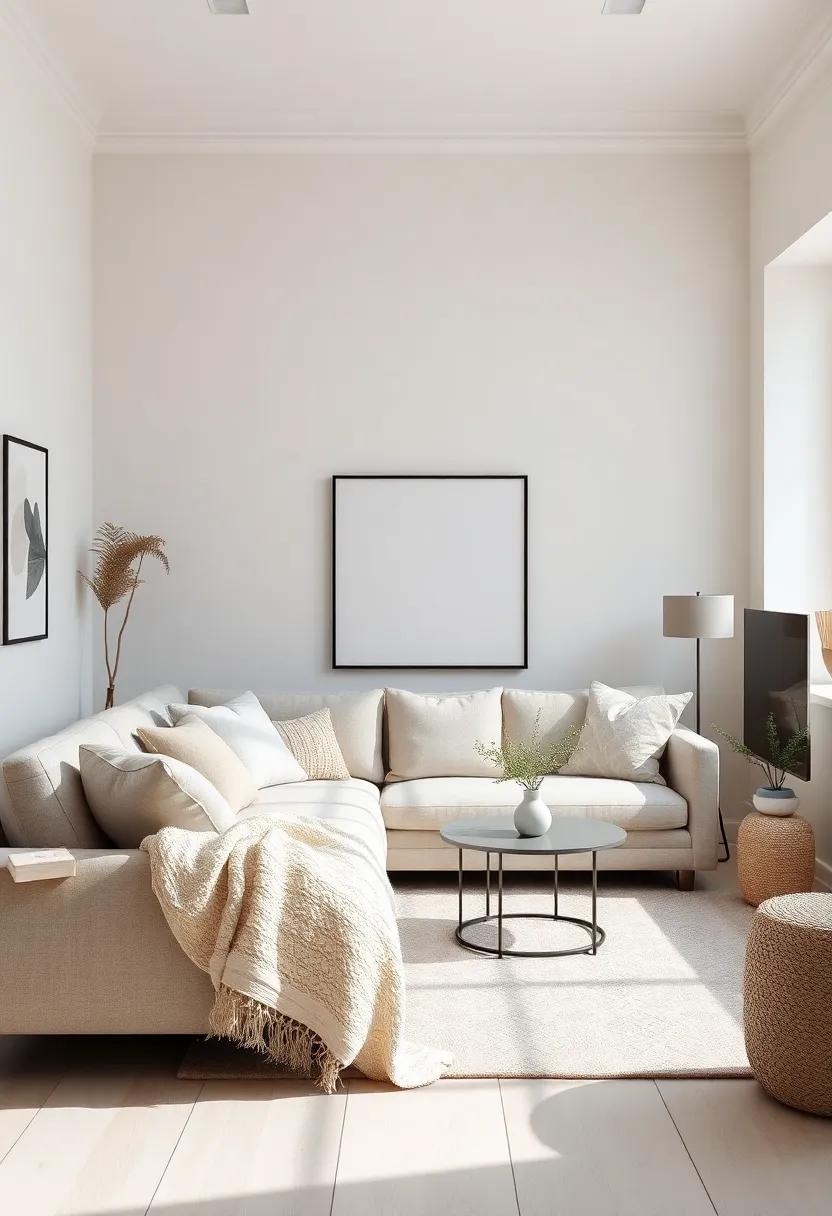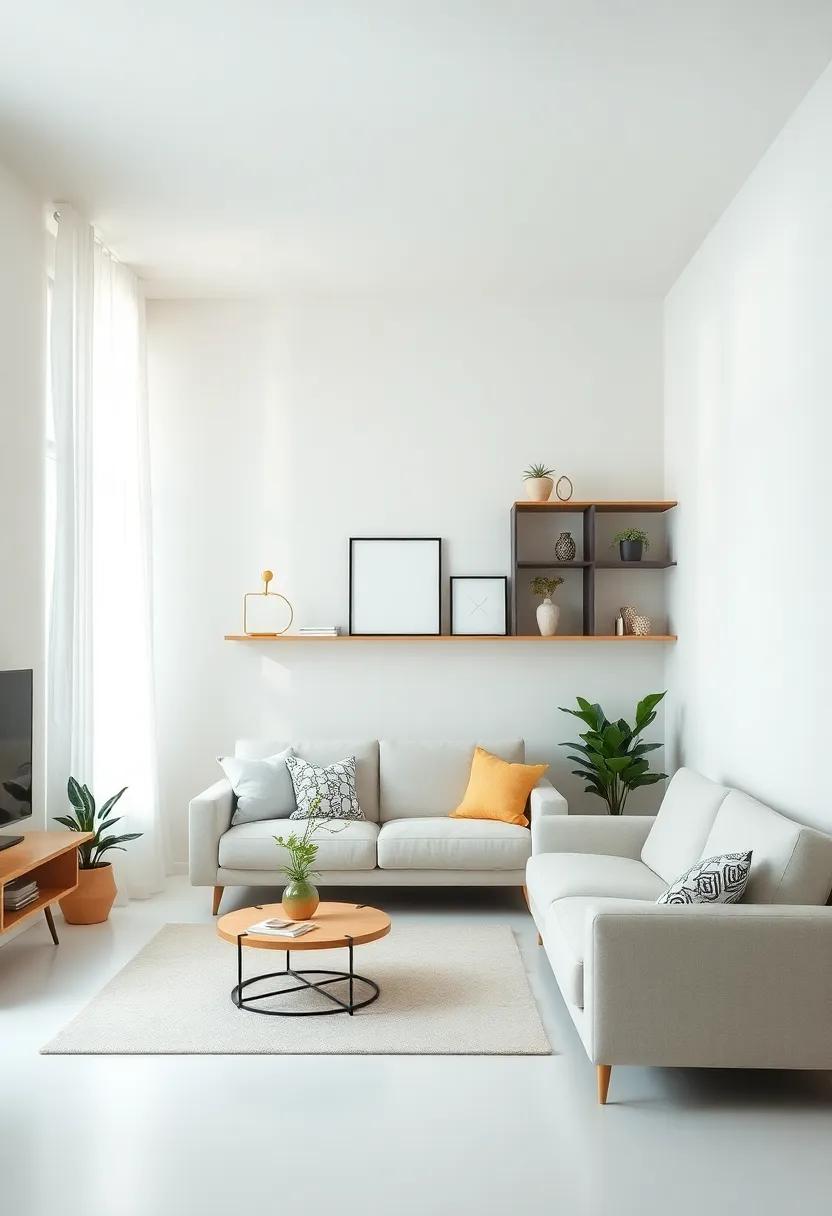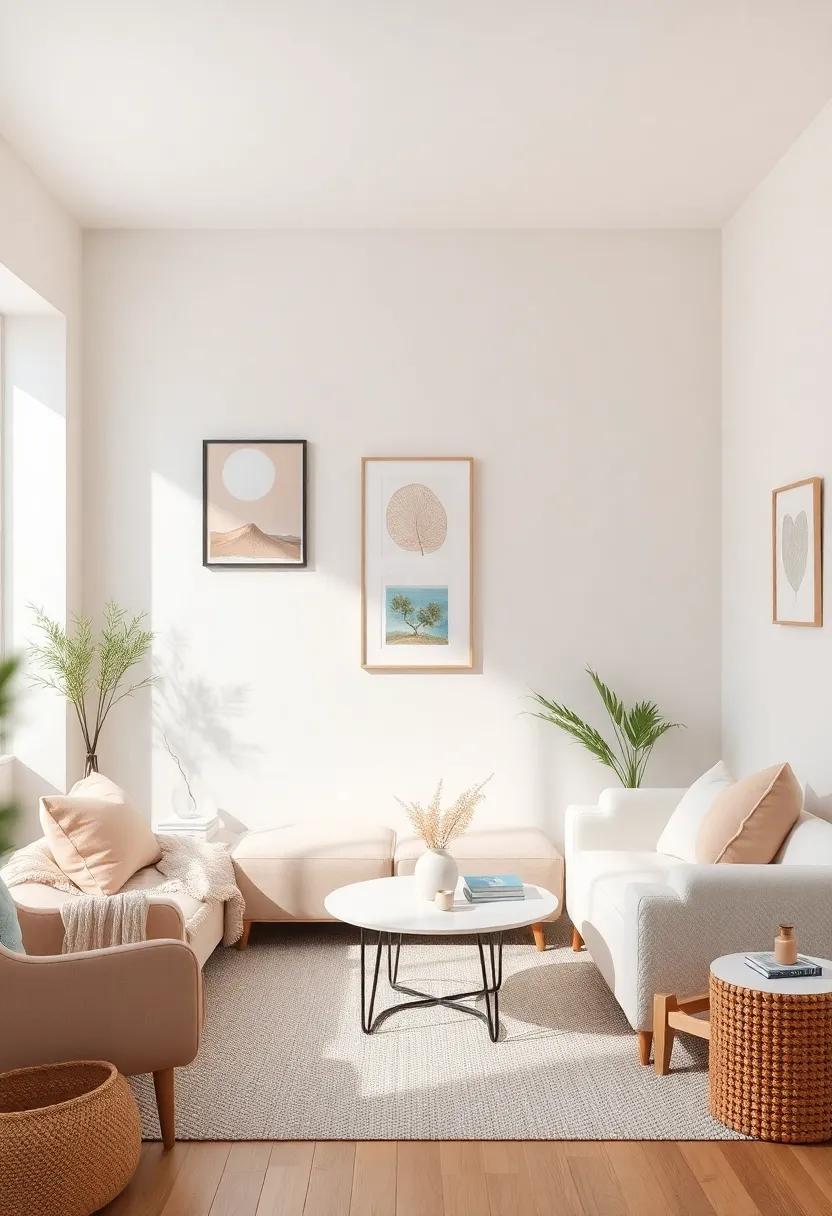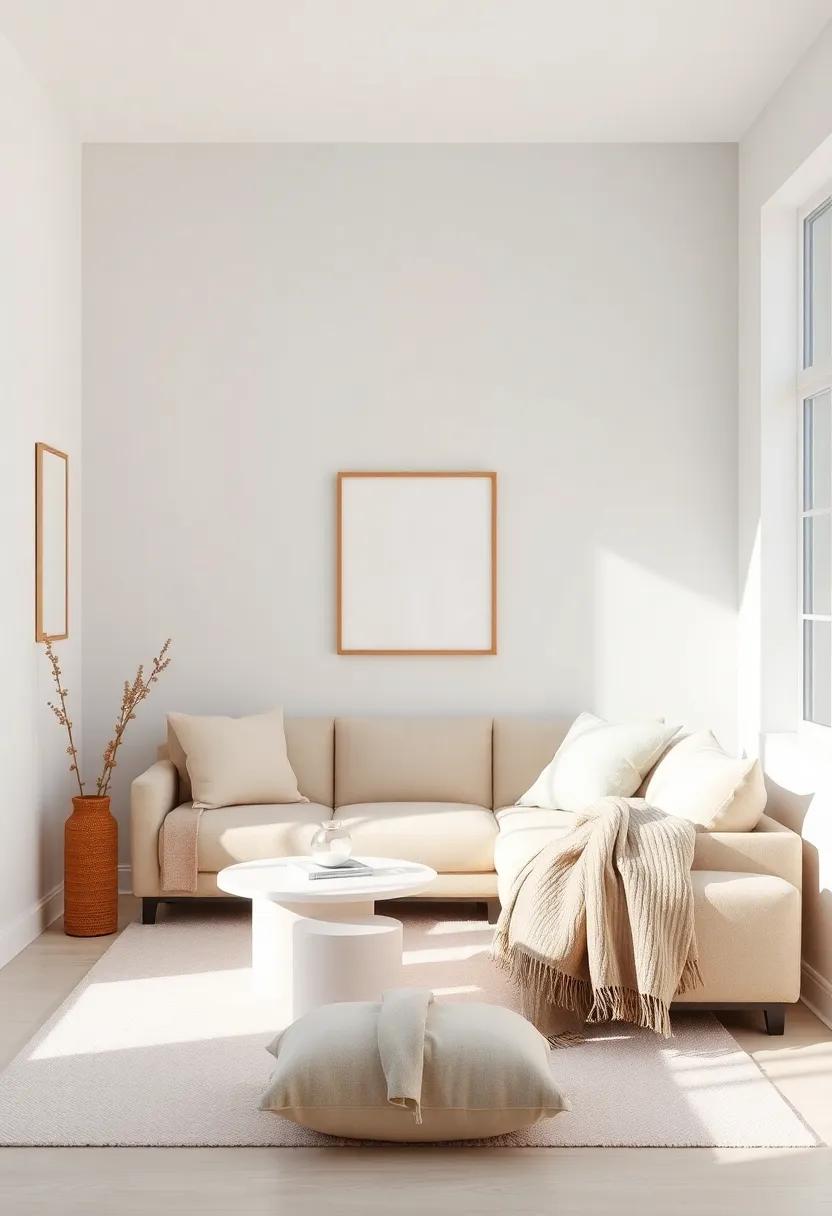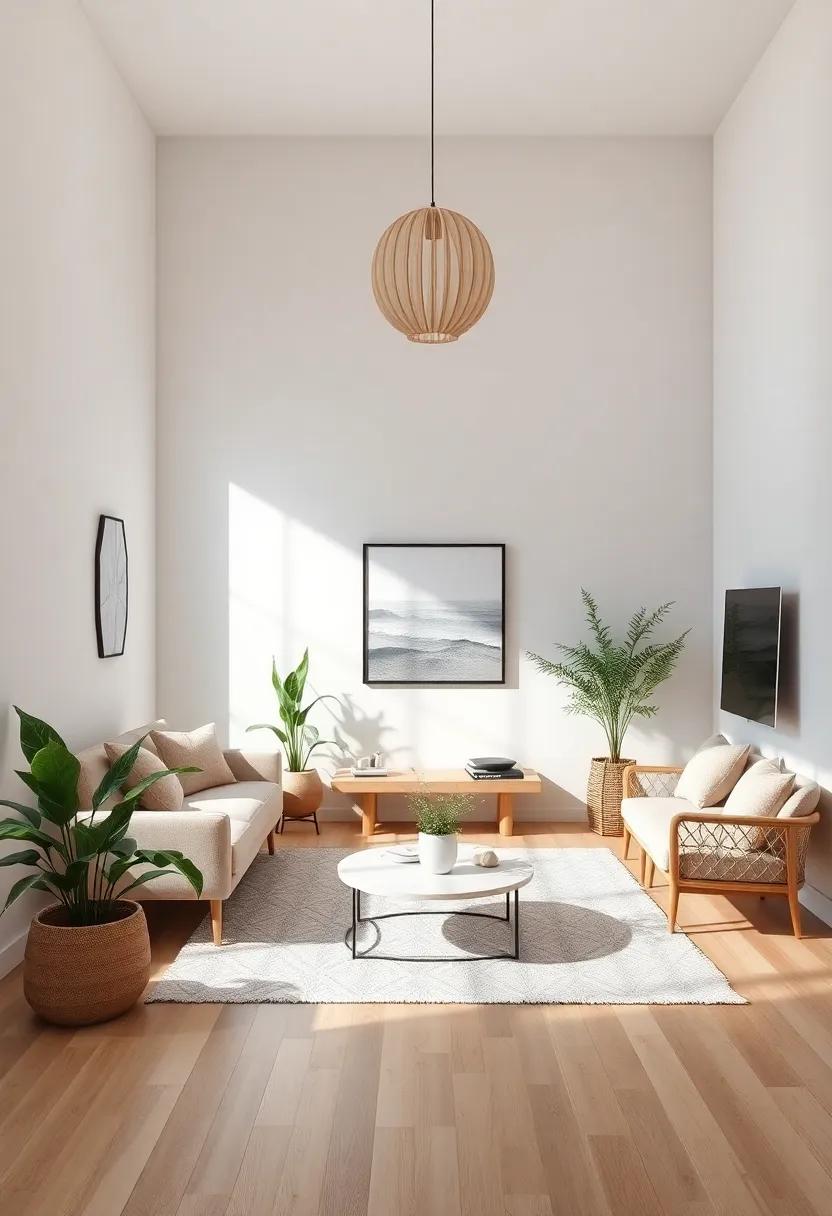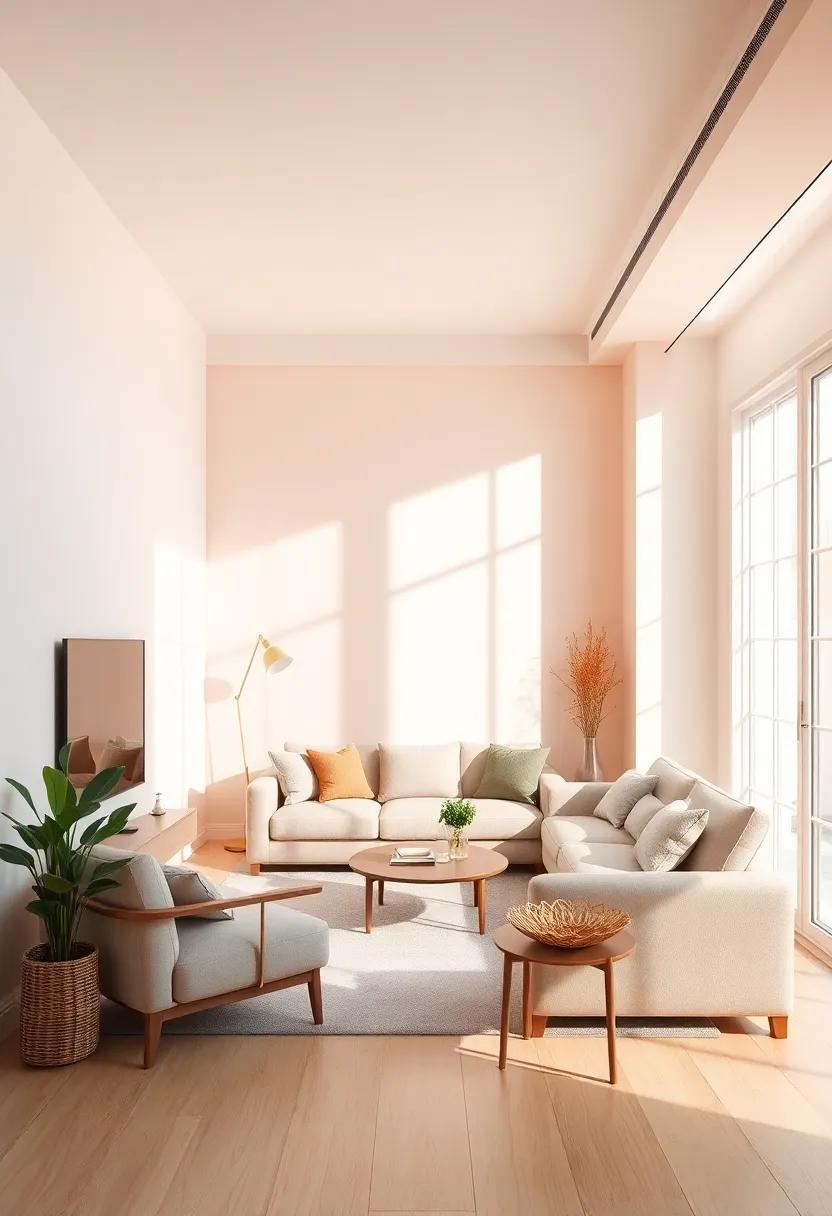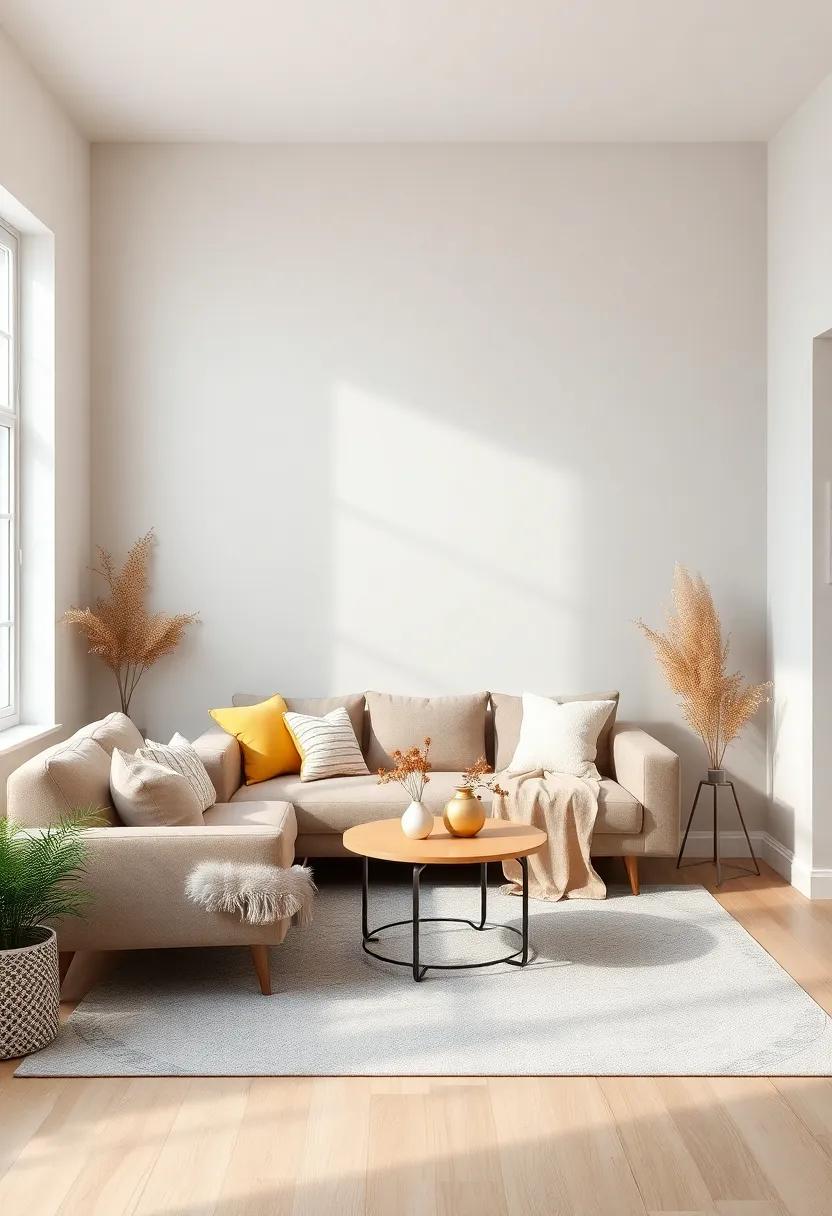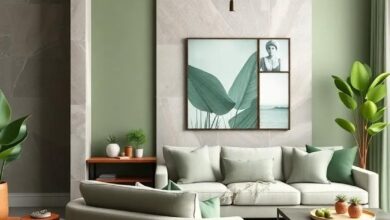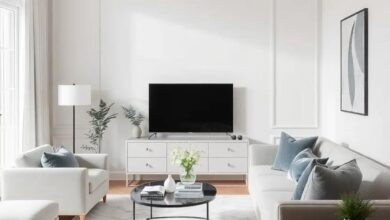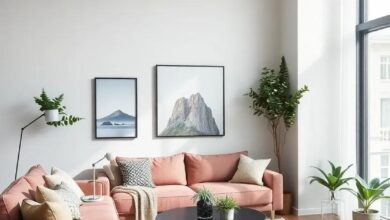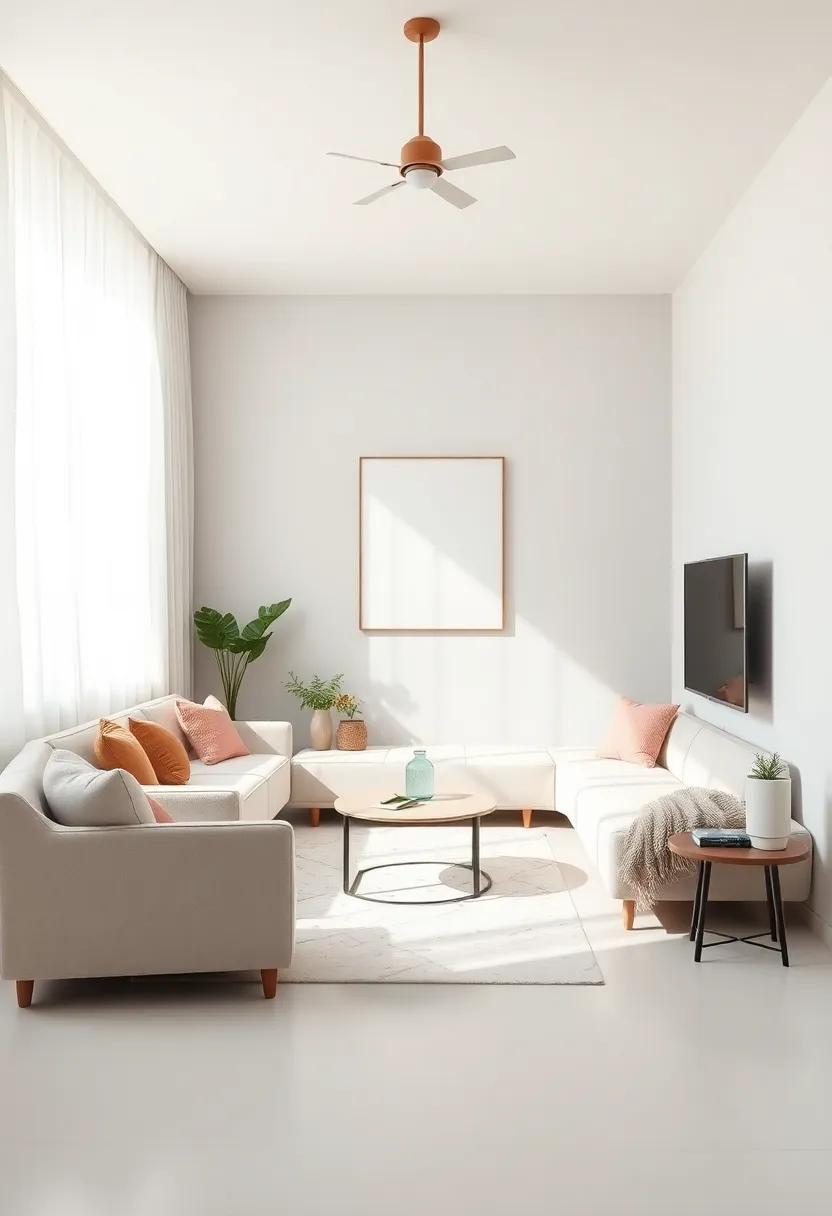
Embracing Serenity: Designing a Cozy Small Living Room with Soft Color Palettes
In a world that often feels chaotic and fast-paced, the allure of a tranquil sanctuary beckons us to slow down and breathe. The living room—a space where we gather, unwind, and connect—holds the potential to become our personal retreat. When space is limited, the challenge of creating a cozy and inviting atmosphere can feel daunting. Though, by embracing soft color palettes, we can transform even the tiniest of living rooms into havens of serenity. This article explores innovative design strategies and soothing hues that invite comfort and peace, providing you with the inspiration to cultivate a small living room that radiates warmth and tranquility. Step inside as we discover how to infuse your space with gentle tones and thoughtful decor, crafting an intimate corner that nurtures both the soul and the senses.
Creating an Inviting atmosphere with Soft Natural Light in a Small Living Room
To create a welcoming ambiance in a compact living space, harnessing the power of soft, natural light is key. Begin by selecting sheer window treatments that allow sunlight to filter in gently, casting a warm glow across the room. Light-colored walls, possibly in soothing pastels or creamy whites, will reflect this natural radiance, amplifying the sense of openness. Consider adding mirrors strategically to bounce light throughout the space; a gorgeous wall mirror or a mirrored coffee table can double as a decor piece while visually expanding the area. For those with limited access to windows, incorporate soft LED lights that mimic daylight. Here are some ways to enhance your lighting experience:
- Layer lighting: combine ambient, task, and accent lights for depth.
- Position furniture wisely: Arrange seating to face light sources or mirrors.
- Add greenery: Plants can absorb light while bringing a touch of nature indoors.
Choosing light,airy fabrics for furniture and decorative cushions further complements this serene atmosphere. Soft textiles in muted tones can create a visual cohesion, inviting people into a space that feels both comforting and spacious. For a touch of personality, accent with a few textured throws or patterned pillows that echo the earthiness of natural elements.Remember to integrate elements like a delicate table lamp or wall sconces that provide gentle lighting without being harsh on the eyes. This harmonious approach not onyl fosters relaxation but also enhances the overall beauty of your small living room.
- Cushions: Opt for down or polyester fills that remain plush.
- Sofas: Choose those with low profiles to keep the eye level unobstructed.
- Rug Choices: A lighter, softer rug can ground the space without overwhelming it.
For resources on creating serene spaces, visit Houzz for design inspiration and tips.
Choosing the Perfect Soft Color palette for a Cozy Ambiance
Creating a warm and inviting space is essential for transforming a small living room into a cozy retreat. Soft color palettes play a crucial role in achieving this atmosphere. When selecting your colors, consider shades that evoke calmness and comfort. Muted pastels like blush pink, mint green, and light lavender can blend harmoniously with nature-inspired tones such as soft beige and pale grey. Together, thes colors create a serene backdrop that encourages relaxation, making them ideal for a gathering space or a quite reading nook.
To effectively implement your palette, think about layering textures and colors throughout the room. Incorporate gentle fabrics such as fluffy throw pillows, cozy blankets, and soft area rugs to enhance the comfort factor. Utilize natural light by keeping window treatments light and airy, allowing colors to pop without overwhelming the senses. It can also be beneficial to have a color swatch board handy for comparison, ensuring that your chosen hues complement each other. Here’s a simple table to illustrate some popular soft color pairings that work beautifully in a small living room:
| Primary Color | Complementary Accent |
|---|---|
| Blush Pink | soft Sage Green |
| Pale Blue | Warm Taupe |
| Light Lavender | Creamy White |
Don’t underestimate the power of accessories in your soft color scheme. Incorporate art pieces, decorative plants, and subtle metal finishes to add interest while maintaining a cohesive look. For more inspiration and tips on color psychology, visit Color Psychology.
Incorporating Textured Fabrics to Enhance Comfort in Your Living space
When designing a cozy small living room, the incorporation of textured fabrics can transform the space into a sanctuary of comfort and warmth. Opt for an array of textiles such as:
- Soft linen for curtains that gently filter natural light;
- Plush velvet for throw pillows that invite you to sink into relaxation;
- Knit throws that add both warmth and a casual touch to your seating.
By layering these different materials, you create visual and tactile richness that enhances the overall ambiance of your living area.
Additionally, consider introducing texture through your choice of furniture and accessories. A cozy armchair upholstered in boucle fabric not only provides a chic aesthetic but also brings a soft yet durable element to the room. Mixing textures can be achieved by combining various shapes and fabrics. As an example, placing a sleek leather sofa alongside a chunky woven rug creates an captivating juxtaposition. Complement this with a natural wood coffee table and you’ll achieve a harmonious balance that encourages tranquility. For inspiration on fabric choices and more interior design ideas, visit houzz.com.
Utilizing Multi-Functional Furniture to Maximize Space and Style
When designing a small living room, integrating multi-functional furniture can be a game changer, seamlessly blending style with practicality. Consider the following versatile pieces to make the most of your available space:
- Sofa Beds: Perfect for accommodating guests while also serving as a cozy seating area.
- Coffee Tables with Storage: These provide a stylish centerpiece and a hidden place to store books, blankets, and games.
- Ottomans: Use them as footrests, extra seating, or storage units – they adapt to your needs effortlessly.
- Wall-Mounted Desks: Ideal for small spaces, these can fold away when not in use, keeping the area sleek and uncluttered.
By selecting items with soft hues and clean lines, you create an atmosphere of calm and tranquility while maximizing every square foot. The key lies in choosing furniture that not only serves multiple purposes but also complements the serene color palette, enhancing the overall aesthetic. As an example,a light grey sectional might beautifully contrast with pastel-colored decor,creating a cohesive look. To inspire your design journey,visit Apartment Therapy for innovative ideas on multifunctional furniture and decor.
Enhancing Comfort with layered Lighting Solutions in a Cozy Room
creating a cozy atmosphere in your small living room requires more than just soft colors; it’s essential to consider the impact of layered lighting. This approach combines various light sources, allowing you to create a dynamic range of moods throughout the day and evening. By incorporating ambient, task, and accent lighting, you can enhance both comfort and functionality. For instance, soft overhead lights set a gentle tone, while adjustable table lamps provide the perfect amount of illumination for reading or relaxing. To add depth, consider the use of wall sconces that cast soft light, highlighting artwork or architectural features.
When designing your lighting scheme, aim for a balanced mix that adapts to your specific needs. A dimmer switch can be an invaluable addition, allowing you to adjust the brightness to suit the moment.Additionally, explore smart lighting options, which enable more control over the brightness and color temperatures. Here are some effective solutions to consider:
- Floor Lamps: Ideal for adding height and warmth.
- string Lights: Bring a whimsical touch and softness to the room.
- Table Lamps: Perfect for focused lighting on side tables.
to help visualize these suggestions, here’s a simple overview:
| Lighting Type | Purpose | Recommendation |
|---|---|---|
| Ambient | Overall illumination | Soft LED ceiling fixtures |
| Task | Specific activities | Adjustable table lamps |
| Accent | Highlight features | Wall sconces or spotlights |
With a thoughtfully designed lighting scheme, you’ll create a tranquil space that welcomes relaxation and fosters cherished moments. For more insights on creating pleasant environments, visit Architectural Digest.
Bringing the Outdoors Inside with Indoor Plants and Soft Green Hues
Infusing nature into your small living room can transform it into a serene retreat. Indoor plants not only bring a fresh burst of life but also purify the air, creating a healthier atmosphere. Consider incorporating a mix of low-maintenance greenery such as snake plants, pothos, or peace lilies, which thrive in various light conditions and add visual interest.To enhance this botanical aesthetic, opt for soft green hues in your decor palette. this color choice can be reflected in throw pillows, rugs, or even wall paint, adding a soothing backdrop that echoes the tranquility of nature.
To further enhance the feel of the outdoors,you might explore hanging plants or wall-mounted greenery which saves precious floor space and draws the eye upwards,creating an illusion of height. Incorporating natural materials, such as wooden shelving or bamboo frames, can cohesively tie together your theme. Additionally, consider using light-filtering curtains in soft colors that mimic the gentle morning light, thus allowing your space to breathe while celebrating the beauty of nature indoors.To dive deeper into indoor plant care and selection, check out resources at the Sill for expert advice.
Crafting a Focal Point: Art Pieces That Complement Soft Decor
In designing a small living room that embraces serenity through soft color palettes, carefully selected art pieces can serve as striking focal points that enhance the overall ambiance. When choosing artwork, consider the following elements to ensure harmony with soft decor:
- Color Coordination: Select pieces that incorporate the muted hues of your palette, such as soft blues, gentle greens, or warm neutrals. This creates a seamless visual flow.
- Textural Contrast: Incorporate pieces that introduce texture without overwhelming the space, like a canvas with gentle brush strokes or photographs printed on fine art paper.
- Subject Matter: Opt for serene imagery, such as landscape scenes or abstract forms, which can evoke calm and complement the tranquil atmosphere of your living area.
consider integrating a few smaller pieces that can be grouped together for visual impact. This cluster can draw the eye while providing balance to the room. Consider the following layout ideas for arranging these artworks:
| Arrangement Type | Description |
|---|---|
| Gallery Wall | A collection of small frames with varied art, creating a dynamic yet cohesive look. |
| Single Statement Piece | A larger artwork that stands out as the centerpiece of the room,drawing attention and anchoring the decor. |
| Dynamic Layering | Mix 2D artworks with 3D sculptures or decorative items on shelves to add depth to the design. |
For more inspiration on integrating art with decor, check out Houzz.
Utilizing Area Rugs to Define Spaces and Add Warmth
Adding an area rug can instantly transform a small living room into a cozy retreat, acting as an anchor that delineates different zones within the space. By selecting a rug with soft colors and delicate patterns, you can harmonize the overall aesthetic while ensuring each area flows seamlessly into the next. Consider placing a plush rug under a coffee table to create a relaxed seating area, or use a runner to define a transition space leading to another part of the room. The right rug not only adds texture but also invites warmth, making the space feel inviting and lived-in.
when choosing the perfect area rug, pay attention to the size and shape to ensure it complements your furniture arrangement. Here are a few tips for selecting an area rug that enhances your living room:
- Size Matters: Aim for a rug that allows at least the front legs of your furniture to rest on it.
- Style Harmony: Choose rugs that echo your color palette or pattern styles to maintain visual coherence.
- Texture Variation: Incorporate different textures to create depth and interest.
For those considering a more structured approach,here’s a simple table outlining popular rug styles and their characteristics:
| Rug Style | Characteristics |
|---|---|
| Shag | Soft,high-pile texture that adds a cozy feel. |
| Flatweave | Light and easy to clean; available in various patterns. |
| Traditional | frequently enough features intricate designs and rich colors. |
Rugs can also serve as a statement piece, drawing focus and enhancing the overall decor of your space. Whether you opt for a bold print or a subtle hue, the right area rug can complement your design vision while providing an inviting atmosphere. For inspiration on choosing the perfect rug for your small living room, visit rugkind.com.
Designing a Reading Nook with Soft Decor and Inviting Soft Lighting
Creating a reading nook is all about ensuring comfort and an inviting atmosphere.Start by selecting plush textiles such as soft throw pillows and cozy blankets to make the space feel cozy and warm. Choose materials that invite touch, like velvet or cotton, and consider layering textures to enhance the sensory experience. Color palettes play a crucial role; opt for muted tones such as muted pastels, soft grays, or warm neutrals to set a calming vibe.Accent your nook with a comfortable chair or oversized bean bag that beckons you to curl up with a good book.
To complement the soft furnishings, think about your lighting options. Soft, warm lighting can dramatically change the atmosphere of your nook. Incorporate table lamps or floor lamps with dimmers to adjust the brightness as needed, creating a perfect ambiance for day or night reading. Consider using LED string lights for a whimsical touch or fairy lights i.e., 1000bulbs.com to add a soft glow around shelves or hanging art. Achieving the right balance between comfort and soft lighting not only elevates your nook but also amplifies its inviting essence.
Choosing Window Treatments that Balance Light and Privacy
When selecting window treatments for your small living room, consider options that allow natural light to flow in while maintaining your desired level of privacy.sheer curtains are a popular choice, as they strike a balance by softening harsh sunlight without sacrificing brightness.Another effective solution is to use top-down, bottom-up shades, which give you the versatility to lower the top for light control while keeping the lower part up for privacy. The right blend of fabric and color can also enhance the serenity of your space, creating a soothing backdrop for relaxation.
To further personalize your window treatments,think about integrating layers that contribute both style and functionality. For example, you could pair sheer drapes with heavier blackout curtains. this combination allows for versatility: during the day, you can draw back the heavy curtains to let in light, while at night, you can close them to shield your living room from outside view. Additionally, consider adding valances at the top to complete the look, tying everything together with your soft color palette. Here’s a speedy reference table for choosing materials:
| Material | Light Control | privacy Level |
|---|---|---|
| Sheer Fabric | High | Low |
| Blackout Curtains | Low | High |
| Cellular Shades | Medium | Medium |
| Natural Fibers (e.g., Bamboo) | Medium | Medium |
For more inspiration on window treatment ideas that perfectly enhance the ambiance of your living room while balancing light and privacy, visit Houzz.
Mixing Soft Textiles for a Cozy, Layered Look in Your Living Area
To create a warm atmosphere in your living area, mixing soft textiles is key. Start by selecting a foundation of light, neutral fabrics such as cotton or linen for your curtains and large upholstered furniture. These fabrics not only allow for natural light to filter through but also create a breathable habitat. Layer in plush throw blankets and an assortment of cushions in complementary shades: think soft pastels or muted earth tones.Consider using a mix of textures, like adding velvet or knitted throws; they not only build depth but also invite relaxation. You can enhance the feeling of coziness with fabrics that change in texture but remain within the same color palette, allowing for a seamless blend that is visually appealing yet soothing.
incorporating different patterns can also add character, but it’s essential to keep them harmonious. Aim for a combination of stripes, dots, and subtle florals in your pillow covers or area rugs. Pay attention to the scale of the patterns; larger prints work well in spacious settings while smaller prints can create intimacy in a small room.Arrange your seating area to promote conversation by layering small rugs under furniture pieces or placing a large rug underneath to unify the space. By thoughtfully selecting and arranging these soft textiles, you will cultivate a serene atmosphere, making your cozy living area an inviting sanctuary for relaxation and connection. for more inspiration on creating soft textiles,check out Houzz.
Maximizing Vertical Space with Shelving for decor and storage
Utilizing vertical space effectively can transform your small living room into a haven of beauty and association. By incorporating open shelving, you can showcase decor items while keeping your essentials within arm’s reach. Consider the following tips to maximize this space:
- Layered Liveliness: Install shelves at varying heights to create a dynamic visual appeal. Use the upper rows for more decorative items, while keeping functional items below.
- Color Coordination: Match your shelf decor with the soft color palette of your room. This will create a cohesive look that enhances the serene atmosphere.
- Multi-Functional decor: Choose decorative boxes or baskets that can store items while being aesthetically pleasing. This not only keeps things tidy but adds texture and depth to your design.
An effective way to further enhance your shelving system is through the thoughtful arrangement of your belongings. Arrange items in groups of three for a naturally appealing look. Here’s a simple guide to help:
| Item Type | Placement |
|---|---|
| Books | Mix upright and stacked for variety |
| Plants | Height variation adds life and color |
| Personal Mementos | Flank books or plants to create interest |
for more inspiration and tricks on maximizing your space with shelves, check out House Beautiful.
Creating a Serene Atmosphere with Scented Candles and Soft Fragrances
Transforming your small living room into a sanctuary of tranquility begins with the gentle glow and calming scents of candles. Choose scented candles that evoke a sense of peace; think of lavender, chamomile, or sandalwood. Position these candles strategically around the room—on a coffee table, windowsills, or shelving units—to create soft pools of light that invite relaxation. Pair your candle selection with soft fragrances from essential oil diffusers or wax melts, enhancing the aromatic landscape of your cozy space. The combination of warm flickering lights and delightful scents envelops the room, helping to dissolve stress and create a serene retreat from the outside world.
When selecting fragrances, consider incorporating seasonal themes to keep the atmosphere fresh and inviting. A carefully crafted aromatic palette can include:
- Winter: Cozy nutmeg and warm cinnamon
- Spring: bright citrus and refreshing green tea
- Summer: Light jasmine and soothing sea breeze
- Fall: earthy pumpkin spice and comforting vanilla
Creating a serene atmosphere also involves selecting candle holders that complement your soft color palette. Opt for natural materials like wood or ceramic in muted tones to blend seamlessly with your decor. combining these elements not only adds a touch of style but also fosters a harmonious space where you can unwind and escape the chaos of daily life. for more inspiration on candle choices and fragrances, you can explore bath & body Works.
Curating Personal Touches: Memories and decor in Soft Hues
In a small living room, the key to curating a cozy atmosphere lies in weaving personal memories into the decor. Opt for soft-hued throw pillows that evoke tranquility while featuring images or patterns that resonate with your past experiences. Incorporate framed photographs of cherished moments arranged on floating shelves to keep the space feeling organized yet personal.A delicate table centerpiece, such as a vintage vase holding dried flowers, can evoke nostalgia and add character without overwhelming the senses.
To amplify the soft palette, consider introducing elements like handmade quilts or textured blankets that invite warmth and comfort. Utilize decor items that highlight your individuality, such as a collection of artistic coasters or a unique art piece created by a local artist, which can serve as conversation starters. A well-placed soft-hued area rug can harmonize the room while grounding the various decor pieces. Embrace sustainable choices by integrating secondhand finds, transforming them with a fresh coat of paint in gentle tones.For more inspiration on soft color schemes, check out decorilla.com.
Selecting Soft Accents: Cushions and Throws that Enhance Comfort
choosing the right cushions and throws can transform your small living room into a tranquil haven, inviting relaxation and comfort. Consider selecting cushions in soft textures like velvet or cotton blends, which add a tactile warmth to your seating area. Opt for a mix of sizes and shapes to create visual interest while maintaining a cohesive color scheme. Shades of soft blues,gentle greens,and muted pastels can harmonize beautifully with your soft color palette,ensuring a calm aesthetic. When layering pillows, think about incorporating a few with subtle patterns like gentle stripes or floral motifs to inject a bit of personality without overwhelming the space.
Throws are equally essential in achieving a cozy atmosphere. A well-placed throw can serve both a practical and decorative purpose,providing warmth during chilly evenings while enhancing your room’s visual appeal. Consider adding throws made of lightweight knits or fleece in complementary hues to your cushions for an inviting touch. You might also want to showcase your throws in a stylish basket or on a decorative ladder, keeping them easily accessible and beautifully displayed. Utilize various textures and materials to add depth to your decor, ensuring that every element contributes to an environment of serenity and relaxation. For more inspiration on fabric choices, you can visit Pottery Barn.
Incorporating Natural Elements to Create a Calm and serene Retreat
To cultivate a tranquil atmosphere in your small living room, consider bringing in natural elements that resonate with comfort and serenity. Wood finishes,stone accents,and lush greenery can transform the space into a private sanctuary. Begin with wooden furniture or even a reclaimed wood coffee table that adds warmth while serving as a conversation piece. Complement this with soft textiles in natural fibers, such as cotton or linen, for pillows and throws, ensuring the seating remains inviting and cozy.The addition of plants not only enhances air quality but also blurs the line between indoor and outdoor living, creating a refreshing feel that calms the mind and uplifts the spirit.
When choosing colors, lean towards a soft palette that mirrors nature. Pale greens, gentle blues, and earthy neutrals can create an ambiance that promotes relaxation. Incorporate these hues through wall paint, artwork, or décor accents. To further enhance the tranquil vibe, consider using tactile elements such as woven baskets or ceramics that add depth and connection to the earth. A simple way to harmonize all these elements is through a clear layout that maintains flow and openness, inviting positive energy throughout the room. For more ideas on creating a peaceful home environment, visit www.thespruce.com.
Color Psychology: The Impact of Soft Pastels on Mood and Relaxation
Soft pastel colors have a remarkable ability to evoke feelings of tranquility and calmness, making them ideal for small living rooms where relaxation is a priority. These delicate hues,ranging from mint greens to gentle lavenders,create an inviting atmosphere that promotes serenity. When integrated into your living space, they can help reduce stress and create a visual balance that encourages leisure and connection. These soothing shades are not only aesthetically pleasing but also influence our emotions profoundly, often resulting in a sense of well-being. Choosing pastel fabrics for furniture or wall colors is a simple yet effective way to foster an uplifting ambiance.
A strategic blend of soft color palettes can enhance the sense of space, making a small room feel more open and airy. Consider the following tips for incorporating pastels into your design:
- Accent Walls: Use a soft pastel color on one wall to make it a focal point.
- Textiles: Choose pastel throw pillows and blankets to add comfort and unity.
- Artwork: Hang soft-colored prints or pastel-themed art to harmonize the décor.
- Accessories: Incorporate decorative items in pastel shades to enhance the overall ambiance.
By embracing these gentle tones in your living space, you not only invite relaxation but also create a cozy refuge that reflects your personality. For more insights into color psychology, visit colorpsychology.org for an in-depth exploration.
Designing a harmonious Flow Between Rooms with Soft Color Connections
Creating a serene atmosphere in your small living room begins with establishing a seamless connection between rooms through the use of soft color palettes.As a notable example, consider incorporating *muted pastels* or *subtle earth tones* that extend into adjoining spaces. This not only amplifies the sense of openness but also promotes visual continuity and a feeling of tranquility throughout your home. Soft hues, such as light blues, gentle greens, and soft blushes, can act as a unifying theme when used across various elements—be it walls, furnishings, or decorative accents. By selectively applying these colors, you can gently guide the eye from one room to another, making transitions feel more inviting and cohesive.
To achieve a harmonious flow, think about implementing a few strategic design choices:
- Accent Walls: A feature wall in a subtle shade can bridge the color gap between two rooms.
- Open Shelving: Use open shelves to display items that share a color scheme, drawing attention to the connected spaces.
- Complementary Accessories: Add throw pillows, art pieces, or rugs that mirror the chosen soft colors to maintain continuity.
By layering these elements thoughtfully,you can design a small living room that not only feels cozy but invites a serene flow,ensuring each area complements the next. For further inspiration on soft color palettes, visit Elle Decor.
Balancing Functionality and Aesthetic in a Serene Living Room Layout
Creating a serene living room demands a harmonious balance between functionality and aesthetic appeal. Choosing furnishings that are both beautiful and practical is crucial.Opt for a plush sofa that invites relaxation, complemented by a couple of stylish yet functional accent chairs. Incorporate a coffee table that serves as a focal point while providing the utility of storage or surface area for books and beverages. Soft textures and natural materials, such as a woven area rug or linen drapes, add layers of comfort to the space. Enhancing the ambiance can be achieved through decorative elements that reflect tranquility, like artwork with soothing landscapes or minimalistic sculptures.
Lighting plays a pivotal role in fostering a serene environment. Consider incorporating a mix of ambient, task, and accent lighting to create a warm and inviting atmosphere. Use soft, warm bulbs to enhance coziness and install dimmers to easily adjust the brightness according to the mood. For added charm, include soft, flickering candlelight or a stylish floor lamp that complements your overall design. Don’t forget to introduce greenery through indoor plants, which not only uplift the aesthetic but also purify the air, boosting the room’s functionality. For more inspiring ideas on creating peaceful spaces, explore resources like Architectural Digest.
Planning for Seasonal Changes: Adapting Colors and Fabrics for Year-Round Coziness
As the seasons shift and transform our surroundings, it’s essential to reflect this evolution inside our cozy living rooms. Embracing a soft color palette creates an opportunity to synchronize your space with nature’s changes.For spring, think of incorporating pastel blues and soft greens through cushions, curtains, or wall art. In the summer, lighter fabrics like cotton and linen not only provide breathability but also lend a fresh vibe when paired with bright yet subtle colors such as peach or lavender. Autumn invites deeper hues like warm terracotta or rich mustard,transforming your cozy corner into a snug retreat with wool or knitted throws. Winter calls for the luxurious embrace of plush textures—consider velvet cushions in deep navy or emerald green to foster warmth during the colder months.
When selecting fabrics for different seasons, consider their functional traits alongside aesthetics. A combination of textures can enrich visual depth while ensuring year-round comfort. Here’s a quick rundown of some delightful fabric pairings:
| Season | Suggested Colors | Ideal Fabrics |
|---|---|---|
| Spring | Pastel Blue, Soft Green | Cotton, linen |
| Summer | Bright Peach, Lavender | Lightweight Fabrics |
| Autumn | Terracotta, Mustard | Wool, Knitted Fabrics |
| Winter | Deep navy, Emerald Green | Velvet, Fleece |
By mindfully altering your decor to correspond with each season’s palette and fabric options, your living room will not only appear cohesive but also maintain its inviting character all year round. For more inspiration on creating a serene living space, visit houzz.
Concluding Remarks
As we conclude our journey through the art of creating a serene and cozy small living room, we are reminded that the colors we choose can substantially shape our emotional landscape. By embracing soft palettes, we invite tranquility into our everyday spaces, allowing us to unwind and recharge in an environment tailored to comfort.
In the delicate interplay of hues—pastel blues, gentle greens, and warm neutrals—we can transform our living areas into havens of peace, where each corner encourages relaxation and connection. Whether it’s through the selection of furnishings, the arrangement of light, or the accents that tell our unique story, the mastery of design lies in the details, inviting us to savor the moments spent within.
So, gather inspiration, infuse your personality, and don’t be afraid to experiment. Your small space has boundless potential to reflect your serenity, welcoming both you and your guests into a sanctuary of warmth and ease. Embrace the process, and let your cozy small living room be a canvas for calm. After all,in the hustle and bustle of life,finding solace in our surroundings is a gift worth cherishing.
As an Amazon Associate I earn from qualifying purchases.
